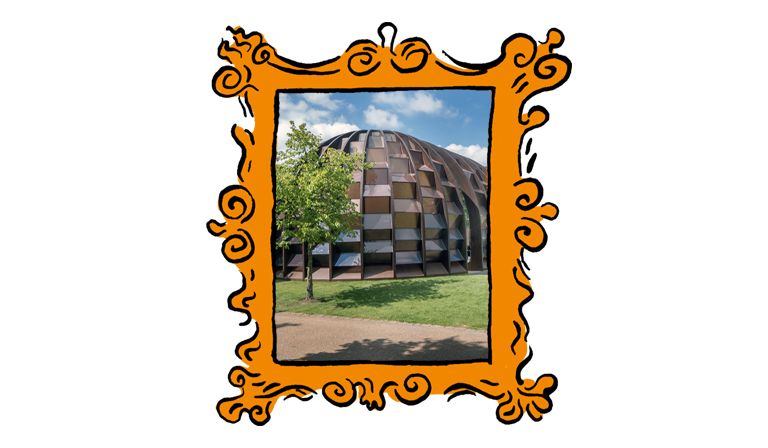This year’s monsoon in Bangladesh already threatens to be heavier than normal, echoing the devastating floods last year. Between 2000 and 2019, Bangladesh experienced 185 extreme weather events, including cyclones, heatwaves, flooding and droughts.
Bangladeshi architect Marina Tabassum is experienced in designing responsive, mobile architecture for this liquid landscape. The architect’s Serpentine Pavilion, which opened on 6th June for its summer tenure in London’s Kensington Gardens, may not be sited in the floodplains of Bangladesh—but through it she has found an ideal space for exploring architecture’s “transient nature”, in ways both obvious and not.
In Tabassum’s pavilion, colossal timber ribs extend like the bellows of a concertina across the lawn in front of the Serpentine Gallery. Capped by two dramatic apses, the nave of diffused light is a modern incarnation of the vast palm houses of Chatsworth or Kew; the ribcage parts to welcome visitors and accommodate a ginkgo tree at its centre.
In place for just five months, the pavilion’s existence in London is brief before it is sold, after which it may resume life elsewhere. “We started our design from what we would like to see this building as in its afterlife,” Tabassum says. She hopes that the project will be reused as a library, an idea encouraged by the shelves installed around its perimeter and furnished with a collection of books celebrating Bengali literature and culture.
Conversations around the structure’s purchase are still ongoing, even if the sale itself is in little doubt. The selling of the pavilion is crucial to the project’s financial model—previous editions have reportedly attracted around £500,000. Yet Tabassum’s ambitions contrast with the fate of most of its predecessors, the majority of which have been purchased by private galleries or art collectors and become accessible to only an elite few. Toyo Ito’s crisscrossed white cuboid from 2002 is now an exclusive venue in the grounds of a Saint Tropez hotel, while the sunken structure by Herzog & de Meuron and Ai Weiwei from 2012 sits in the Surrey estate of Lakshmi Mittal, chair of steel company ArcelorMittal. The first ever pavilion, on the other hand, designed in 2000 by Iraqi-British architect Zaha Hadid, has had a less salubrious life: for the last 20 years her ETFE and steel tent was used as a marquee by Flambards Theme Park in Cornwall. The theme park closed in November 2024; the future of the late starchitect’s work is unclear.
Smiljan Radić’s pebble-like pavilion from 2014 has had one of the more publicly accessible afterlives, now situated in the free-to-enter garden of Hauser & Wirth’s gallery in Somerset, while Sou Fujimoto’s delicate steel grid structure from 2013 remains outside the (currently closed) National Gallery in Tirana, Albania. Tabassum hopes to suggest to potential buyers its intended future, though the Serpentine would not confirm if the architect’s intention would be taken into account. Indeed, if Tabassum’s suggestion was honoured—and her pavilion really did become a public library—it would certainly be the first time.
Tabassum says her emphasis on guiding the pavilion’s future use is part of the project’s sustainability credentials—by “not adding to landfills,” as she puts it. Rightly, her pavilion is overall much more ecologically conscious than those of the past. Previous foundations have been reclaimed where possible, while the translucent sections between the pavilion’s ribs are made of polycarbonate sheets, rather than glass—which, although plastic and held by a secondary steel structure, are lighter and less carbon intensive. Tabassum had also originally hoped to dress the structure in a coat of jute fibres, a plan sadly denied by fire regulations. The ribs themselves have been built with glulam timber sourced in the UK, but further detail on their provenance is not readily available. (Wood absorbs carbon dioxide from the atmosphere as it grows, meaning it has a low carbon cost, though long transportation distances and poorly managed forestry—as well as vast forestry monocultures—can detract from this.)
These decisions are somewhat undermined by the pavilion’s enormous scale: standing at 7.5 metres tall and 30 metres long, its spatial generosity is impressive but structurally and materially demanding. The structure is also, in other ways, not large enough; the gaps between segments mean that a colossal 10-tonne section of the structure has to be moveable to create a single space big enough for 200 people, a demand of the pavilion brief that required a hydraulic machine to be installed beneath it.
Despite my requests to the Serpentine for an embodied carbon figure for the pavilion—an estimate of the carbon emissions created by a building’s construction—that information was not forthcoming. Today, the contribution of building construction to ecological and climate degradation has resulted in moratoria around the world on the demolition of existing buildings and even calls to halt all new construction. In light of this, the expending of precious resources on a new structure nearly every year, as the Serpentine Gallery has done since 2000, appears increasingly frivolous and out-of-step.
The role of financial institutions in the climate catastrophe should also not be forgotten. Since 2014, the pavilion has been sponsored by the investment bank Goldman Sachs. At the end of last year, the bank withdrew from the Net-Zero Banking Alliance, a coalition of financial institutions advocating for climate mitigation in line with the Paris agreement, and was fined $4m in 2022 for failing to comply with its own Environmental, Social and Governance policies.
Tabassum argues that the money “has to come from somewhere” and that “if you trace back to the finances, you’ll always find something”—a resignation to compromised financial backing that will be familiar to many architects and creative practitioners. Instead, Tabassum emphasises the benefits of such backing: to “promote art” which “is made free for people”.
While Tabassum’s concerns for sustainability and public accessibility are admirable, they remain complicated by the Serpentine Pavilion’s broader ecosystem, along with the economic mechanisms significantly contributing to climate breakdown—and the extreme flooding in Bangladesh.
Bangladeshi architect Marina Tabassum is experienced in designing responsive, mobile architecture for this liquid landscape. The architect’s Serpentine Pavilion, which opened on 6th June for its summer tenure in London’s Kensington Gardens, may not be sited in the floodplains of Bangladesh—but through it she has found an ideal space for exploring architecture’s “transient nature”, in ways both obvious and not.
In Tabassum’s pavilion, colossal timber ribs extend like the bellows of a concertina across the lawn in front of the Serpentine Gallery. Capped by two dramatic apses, the nave of diffused light is a modern incarnation of the vast palm houses of Chatsworth or Kew; the ribcage parts to welcome visitors and accommodate a ginkgo tree at its centre.
In place for just five months, the pavilion’s existence in London is brief before it is sold, after which it may resume life elsewhere. “We started our design from what we would like to see this building as in its afterlife,” Tabassum says. She hopes that the project will be reused as a library, an idea encouraged by the shelves installed around its perimeter and furnished with a collection of books celebrating Bengali literature and culture.
Conversations around the structure’s purchase are still ongoing, even if the sale itself is in little doubt. The selling of the pavilion is crucial to the project’s financial model—previous editions have reportedly attracted around £500,000. Yet Tabassum’s ambitions contrast with the fate of most of its predecessors, the majority of which have been purchased by private galleries or art collectors and become accessible to only an elite few. Toyo Ito’s crisscrossed white cuboid from 2002 is now an exclusive venue in the grounds of a Saint Tropez hotel, while the sunken structure by Herzog & de Meuron and Ai Weiwei from 2012 sits in the Surrey estate of Lakshmi Mittal, chair of steel company ArcelorMittal. The first ever pavilion, on the other hand, designed in 2000 by Iraqi-British architect Zaha Hadid, has had a less salubrious life: for the last 20 years her ETFE and steel tent was used as a marquee by Flambards Theme Park in Cornwall. The theme park closed in November 2024; the future of the late starchitect’s work is unclear.
Smiljan Radić’s pebble-like pavilion from 2014 has had one of the more publicly accessible afterlives, now situated in the free-to-enter garden of Hauser & Wirth’s gallery in Somerset, while Sou Fujimoto’s delicate steel grid structure from 2013 remains outside the (currently closed) National Gallery in Tirana, Albania. Tabassum hopes to suggest to potential buyers its intended future, though the Serpentine would not confirm if the architect’s intention would be taken into account. Indeed, if Tabassum’s suggestion was honoured—and her pavilion really did become a public library—it would certainly be the first time.
Tabassum says her emphasis on guiding the pavilion’s future use is part of the project’s sustainability credentials—by “not adding to landfills,” as she puts it. Rightly, her pavilion is overall much more ecologically conscious than those of the past. Previous foundations have been reclaimed where possible, while the translucent sections between the pavilion’s ribs are made of polycarbonate sheets, rather than glass—which, although plastic and held by a secondary steel structure, are lighter and less carbon intensive. Tabassum had also originally hoped to dress the structure in a coat of jute fibres, a plan sadly denied by fire regulations. The ribs themselves have been built with glulam timber sourced in the UK, but further detail on their provenance is not readily available. (Wood absorbs carbon dioxide from the atmosphere as it grows, meaning it has a low carbon cost, though long transportation distances and poorly managed forestry—as well as vast forestry monocultures—can detract from this.)
These decisions are somewhat undermined by the pavilion’s enormous scale: standing at 7.5 metres tall and 30 metres long, its spatial generosity is impressive but structurally and materially demanding. The structure is also, in other ways, not large enough; the gaps between segments mean that a colossal 10-tonne section of the structure has to be moveable to create a single space big enough for 200 people, a demand of the pavilion brief that required a hydraulic machine to be installed beneath it.
Despite my requests to the Serpentine for an embodied carbon figure for the pavilion—an estimate of the carbon emissions created by a building’s construction—that information was not forthcoming. Today, the contribution of building construction to ecological and climate degradation has resulted in moratoria around the world on the demolition of existing buildings and even calls to halt all new construction. In light of this, the expending of precious resources on a new structure nearly every year, as the Serpentine Gallery has done since 2000, appears increasingly frivolous and out-of-step.
The role of financial institutions in the climate catastrophe should also not be forgotten. Since 2014, the pavilion has been sponsored by the investment bank Goldman Sachs. At the end of last year, the bank withdrew from the Net-Zero Banking Alliance, a coalition of financial institutions advocating for climate mitigation in line with the Paris agreement, and was fined $4m in 2022 for failing to comply with its own Environmental, Social and Governance policies.
Tabassum argues that the money “has to come from somewhere” and that “if you trace back to the finances, you’ll always find something”—a resignation to compromised financial backing that will be familiar to many architects and creative practitioners. Instead, Tabassum emphasises the benefits of such backing: to “promote art” which “is made free for people”.
While Tabassum’s concerns for sustainability and public accessibility are admirable, they remain complicated by the Serpentine Pavilion’s broader ecosystem, along with the economic mechanisms significantly contributing to climate breakdown—and the extreme flooding in Bangladesh.









